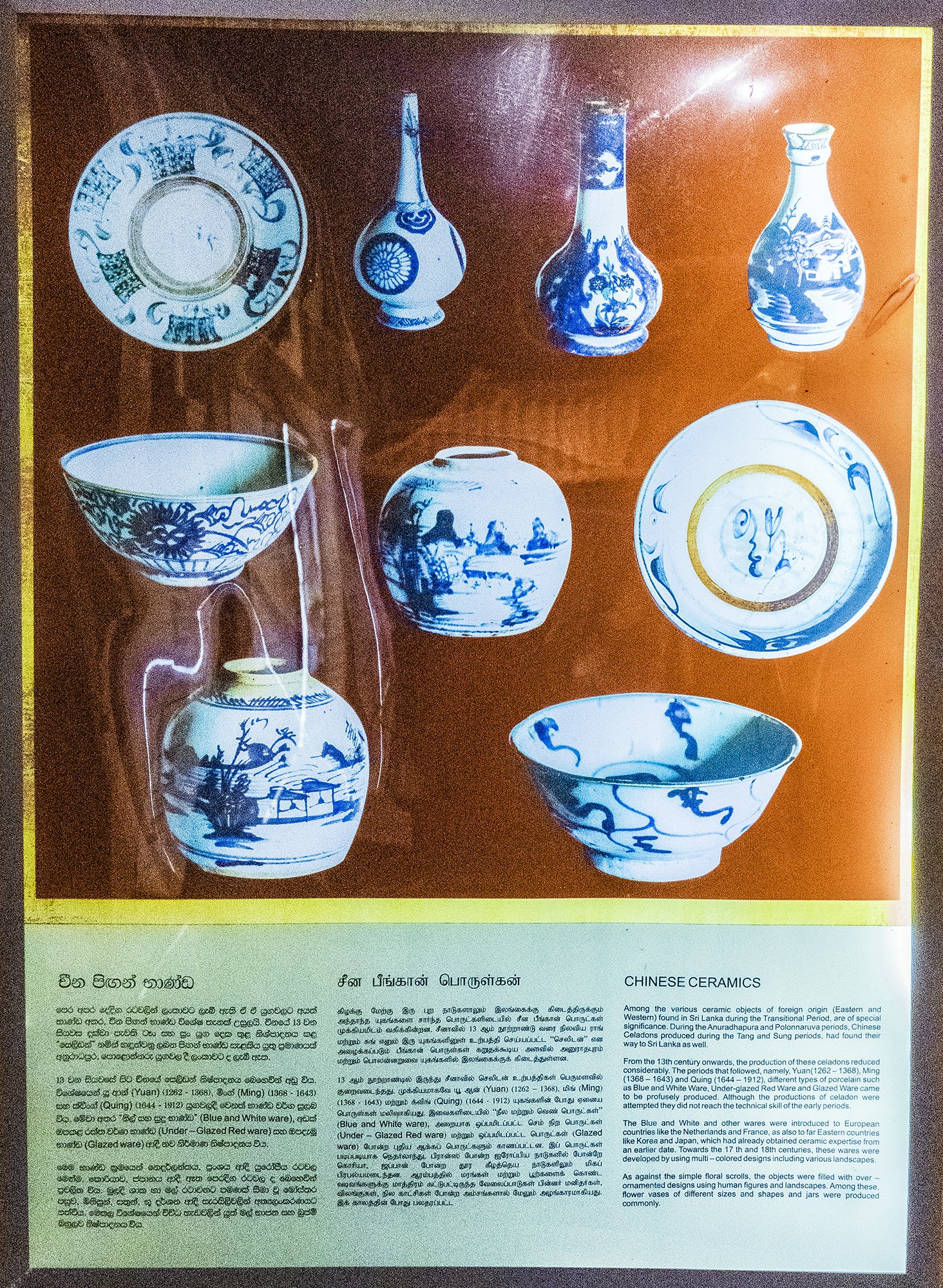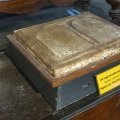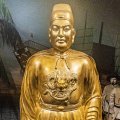Galle National Museum: photo 157
Photo 157 of 172 in Gallery: Galle National Museum

Image title: Chinese Ceramics (in Sri Lanka)
Description of the photo
English text:
Chinese Ceramics — Among the various ceramic objects of foreign origin (Eastern and Western) found in Sri Lanka during the Transitional Period, are of special significance. During the Anuradhapura and Polonnaruva periods, Chinese Celadons produced during the Tang and Sung periods, had found their way to Sri Lanka as well.
From the 13th century onwards, the production of these celadons reduced considerably. The periods that followed, namely, Yuan (1262-1368), Ming (1368-1643) and Quing (1644-1912), different types of porcelain such as Blue and White Ware, Under-glazed Red Ware and Glazed Ware came to be profusely produced. Although the productions of celadon were attempted they did not reach the technical skill of the early periods.
The Blue and White and other wares were introduced to European countries like the Netherlands and France, as also to far Eastern countries like Korea and Japan, which had already obtained ceramic expertise from an earlier date. Towards the 17 th and 18th centuries, these wares were developed by using multi-colored designs including various landscapes.
As against the simple floral scrolls, the objects were filled with over omamented designs using human figures and landscapes. Among these, flower vases of different sizes and shapes and jars were produced commonly.
Sinhala text (not proofread):
චීන පිගන් භාණ්ඩ — පෙර අපර දෙදිග රටවලින් ලංකාවට ලැබී ඇති ඒ ඒ යුගවලට අයත් භාණ්ඩ අතර, චීන පිඟන් භාණ්ඩ විශේෂ තැනක් උසුලයි. චීනයේ 13 වන සියවස දක්වා පැවති ටෑං සහ සුං යුග දෙක තුළ නිශ්පාදනය කළ *සෙළිඩන්" නමින් හඳුන්වනු ලබන පිඟන් භාණ්ඩ සැළකිය යුතු ප්රමාණයක් අනුරාධපුර, පොළොන්නරු යුගවල දී ලංකාවට ද ලැබී ඇත.
13 වන සියවසේ සිට චීනයේ සෙලිඩන් නිෂ්පාදනය බෙහෙවින් අඩු විය. 5 ໘ ໙໖ (Yuan) (1262 - 1368), ໑໐໖ (Ming) (1368-1643) සහ විංග් (Quing) (1644 - 1912) යුග වලදී වෙනත් භාණ්ඩ වර්ග සුලබ විය. මේවා අතර "නිල් සහ සුදු භාණ්ඩ (Blue and White ware), අඩක් ඔප කළ රක්ත වර්ණ භාණ්ඩ (Under - Glazed Red ware) සහ ඔපදැමූ භාණ්ඩ (Glazed ware) ආදී නව නිර්මාණ නිෂ්පාදනය විය.
මෙම භාණ්ඩ ක්රමයෙන් නෙදර්ලන්තය, ප්රංශය ආදී යුරෝපීය රටවල මෙන්ම, කොරියාව, පානය ආදී ඈත පෙරදිග රටවල ද බෙහෙවින් ප්රචලිත විය. මුලදී ශාක හා මල් රටාවනට පමණක් සීමා වූ මෝස්තර පසුව, මිනිසුන්, සතුන්, භූ දර්ශන ආදී සැරසිලිවලින් අත්යලංකරණයට පත්විය. මෙකල විශේෂයෙන් විවිධ හැඩවලින් යුත් මල් භාජන සහ බුජම් බහුලව නිෂ්පාදනය විය.
Transcription:
chīna pigan bhāṇḍa — pera apara dediga raṭavalin laṅkāvaṭa læbī æti ē ē yugavalaṭa ayat bhāṇḍa atara, chīna piṅgan bhāṇḍa viśēṣa tænak usulayi. chīnayē 13 vana siyavasa dakvā pævati ṭǣṅ saha suṅ yuga deka tuḷa niśpādanaya kaḷa *seḷiḍan" namin handunvanu labana piṅgan bhāṇḍa sæḷakiya yutu pramāṇayak anurādhapura, poḷonnaru yugavala dī laṅkāvaṭa da læbī æta.
13 vana siyavasē siṭa chīnayē seliḍan niṣpādanaya behevin aḍu viya. 5 ໘ ໙໖ (Yuan) (1262 - 1368), ໑໐໖ (Ming) (1368-1643) saha viṅg (Quing) (1644 - 1912) yuga valadī venat bhāṇḍa varga sulaba viya. mēvā atara "nil saha sudu bhāṇḍa (Blue and White ware), aḍak opa kaḷa rakta varṇa bhāṇḍa (Under - Glazed Red ware) saha opadæmū bhāṇḍa (Glazed ware) ādī nava nirmāṇa niṣpādanaya viya.
mema bhāṇḍa kramayen nedarlantaya, praṅśaya ādī yurōpīya raṭavala menma, koriyāva, pānaya ādī ǣta peradiga raṭavala da behevin prachalita viya. muladī śāka hā mal raṭāvanaṭa pamaṇak sīmā vū mōstara pasuva, minisun, satun, bhū darśana ādī særasilivalin atyalaṅkaraṇayaṭa patviya. mekala viśēṣayen vividha hæḍavalin yut mal bhājana saha bujam bahulava niṣpādanaya viya.
Transcription:
china pigan bhanda — pera apara dediga ratavalin lankavata labi ati e e yugavalata ayat bhanda atara, china pingan bhanda vishesha tanak usulayi. chinaye 13 vana siyavasa dakva pavati tan saha sun yuga deka tula nishpadanaya kala *selidan" namin handunvanu labana pingan bhanda salakiya yutu pramanayak anuradhapura, polonnaru yugavala di lankavata da labi ata.
13 vana siyavase sita chinaye selidan nishpadanaya behevin adu viya. 5 ໘ ໙໖ (Yuan) (1262 - 1368), ໑໐໖ (Ming) (1368-1643) saha ving (Quing) (1644 - 1912) yuga valadi venat bhanda varga sulaba viya. meva atara "nil saha sudu bhanda (Blue and White ware), adak opa kala rakta varna bhanda (Under - Glazed Red ware) saha opadamu bhanda (Glazed ware) adi nava nirmana nishpadanaya viya.
mema bhanda kramayen nedarlantaya, pranshaya adi yuropiya ratavala menma, koriyava, panaya adi ata peradiga ratavala da behevin prachalita viya. muladi shaka ha mal ratavanata pamanak sima vu mostara pasuva, minisun, satun, bhu darshana adi sarasilivalin atyalankaranayata patviya. mekala visheshayen vividha hadavalin yut mal bhajana saha bujam bahulava nishpadanaya viya.
Automated translation:
Chinese Pottery — Among the goods belonging to different eras that Sri Lanka has received from the previous two countries, Chinese pottery holds a special place. Sri Lanka also received a considerable amount of ceramics known as *celidon' produced during the two dynasties of Tang and Sung which lasted until the 13th century in China during the Anuradhapura and Polonnaru periods.
From the 13th century, the production of celandine in China declined greatly. 5 Other wares were common during the Yuan (1262 - 1368), Ming (1368-1643) and Qing (1644 - 1912) dynasties. Among these were the production of new designs such as Blue and White ware, Under-Glazed Red ware and Glazed ware.
These goods gradually became very popular in European countries such as the Netherlands and France, as well as in the Far East countries such as Korea and Japan. Initially limited to floral and floral motifs, the motifs later expanded to include people, animals, landscapes, etc. At this time, flower pots and flowerpots of various shapes were produced in abundance.
Tamil text (not proofread):
சீன மற்பாண்ட [சீன பீங்கான் பொருள்கன்] — [?]ழக்கு மேற்கு இரு புற நாடுகளாலும் இலங்கைக்கு கிடைத்திருக்கும் [?]ந்தாந்த யுகங்களை சார்ந்த பொருட்களிடையில் சீன பீங்கான் பொருட்கள் [?]க்கியமிடம் வகிக்கின்றன. சீனாவில் 13 ஆம் நூற்றாண்டு வரை நிலவிய ராங் [?]ற்றும் சுங் எனும் இரு யுகங்களினுள் உற்பத்தி செய்யப்பட்ட "செலிடன்" என அழைக்கப்படும் பீங்கான் பொருள்கள் கறுதக்கூடிய அளவில் அனுராதபுரம் மற்றும் பொலன்னறுவை யுகங்களில் இலங்கைக்குக் கிடைத்துள்ளன.
13 ஆம் நூற்றாண்டில் இருந்து சீனாவில் செலிடன் உற்பத்திகள் பெருமளவில் குறைவடைந்தது. முக்கியமாகவே யூ ஆன் (Yuan) (1262 -1368), மிங் (Ming) (1368- 1643) மற்றும் க்விங் (Quing) (1644 - 1912) யுகங்களின் போது ஏனைய பொருள்கள் மலிவாகியது. இவைகளிடையில் "நீல மற்றும் வெண் பொருட்கள்" (Blue and White ware), அறையாக ஒப்பமிடப்பட்ட செம் நிற பொருட்கள் (Under - Glazed Red ware) மற்றும் ஒப்பமிடப்பட்ட பொருட்கள் (Glazed ware) போன்ற புதிய ஆக்கப் பொருட்களும் காணப்பட்டன. இப் பொருட்கள் படிப்படியாக நெதர்லாந்து, பிரான்ஸ் போன்ற ஐரோப்பிய நாடுகளில் போன்றே கொரியா, ஜப்பான் போன்ற தூர கீழத்தெய நாடுகளிலும் மிகப் பிரபல்யமடைந்தன. ஆரம்பத்தில் மரங்கள் மற்றும் பூற்களைக் கொண்ட வடிவங்களுக்கு மாத்திரம் கட்டுபட்டிருந்த வேலைப்பாடுகள் பின்னர் மனிதர்கள், விலங்குகள், நில காட்சிகள் போன்ற அம்சங்களால் மேலும் அழங்காரமாகியது. இக் காலத்தின் போது பலதரப்பட்ட
Transcription:
cīṉa maṟpāṇṭa [cīṉa pīṅkāṉ poruḷkaṉ] — [?]ḻakku mēṟku iru puṟa nāṭukaḷālum ilaṅkaikku kiṭaittirukkum [?]ntānta yukaṅkaḷai cārnta poruṭkaḷiṭaiyil cīṉa pīṅkāṉ poruṭkaḷ [?]kkiyamiṭam vakikkiṉṟaṉa. cīṉāvil 13 ām nūṟṟāṇṭu varai nilaviya rāṅ [?]ṟṟum cuṅ eṉum iru yukaṅkaḷiṉuḷ uṟpatti ceyyappaṭṭa "celiṭaṉ" eṉa aḻaikkappaṭum pīṅkāṉ poruḷkaḷ kaṟutakkūṭiya aḷavil aṉurātapuram maṟṟum polaṉṉaṟuvai yukaṅkaḷil ilaṅkaikkuk kiṭaittuḷḷaṉa.
13 ām nūṟṟāṇṭil iruntu cīṉāvil celiṭaṉ uṟpattikaḷ perumaḷavil kuṟaivaṭaintatu. mukkiyamākavē yū āṉ (Yuan) (1262 -1368), miṅ (Ming) (1368- 1643) maṟṟum kviṅ (Quing) (1644 - 1912) yukaṅkaḷiṉ pōtu ēṉaiya poruḷkaḷ malivākiyatu. ivaikaḷiṭaiyil "nīla maṟṟum veṇ poruṭkaḷ" (Blue and White ware), aṟaiyāka oppamiṭappaṭṭa cem niṟa poruṭkaḷ (Under - Glazed Red ware) maṟṟum oppamiṭappaṭṭa poruṭkaḷ (Glazed ware) pōṉṟa putiya ākkap poruṭkaḷum kāṇappaṭṭaṉa. ip poruṭkaḷ paṭippaṭiyāka netarlāntu, pirāṉs pōṉṟa airōppiya nāṭukaḷil pōṉṟē koriyā, jappāṉ pōṉṟa tūra kīḻatteya nāṭukaḷilum mikap pirapalyamaṭaintaṉa. ārampattil maraṅkaḷ maṟṟum pūṟkaḷaik koṇṭa vaṭivaṅkaḷukku māttiram kaṭṭupaṭṭirunta vēlaippāṭukaḷ piṉṉar maṉitarkaḷ, vilaṅkukaḷ, nila kāṭcikaḷ pōṉṟa amcaṅkaḷāl mēlum aḻaṅkāramākiyatu. ik kālattiṉ pōtu palatarappaṭṭa
Transcription:
sina marpanda [sina pingan porulkan] — [?]zhakku merku iru pura nadugalalum ilangaikku kidaithirukkum [?]nthantha yugangalai sarntha porudkalidaiyil sina pingan porudkal [?]kkiyamidam vagikkinrana. sinavil 13 am nurrandu varai nilaviya rang [?]rrum sung enum iru yugangalinul urpathi seyyappatta "selidan" ena azhaikkappadum pingan porulkal karuthakkudiya alavil anurathapuram marrum polannaruvai yugangalil ilangaikkug kidaithullana.
13 am nurrandil irunthu sinavil selidan urpathigal perumalavil kuraivadainthathu. mukkiyamagave yu an (yuan) (1262 -1368), ming (ming) (1368- 1643) marrum kving (quing) (1644 - 1912) yugangalin pothu enaiya porulkal malivagiyathu. ivaigalidaiyil "nila marrum ven porudkal" (blue and whithe ware), araiyaga oppamidappatta sem nira porudkal (under - glazed red ware) marrum oppamidappatta porudkal (glazed ware) ponra puthiya akkap porudkalum kanappattana. ip porudkal padippadiyaga netharlanthu, pirans ponra airoppiya nadugalil ponre koriya, jappan ponra thura kizhatheya nadugalilum migap pirapalyamadainthana. arambathil marangal marrum purkalaig konda vadivangalukku mathiram kattupattiruntha velaippadugal pinnar manitharkal, vilangugal, nila kadsigal ponra amsangalal melum azhangaramagiyathu. ig kalathin pothu palatharappatta
Automated translation:
Chinese Pottery [Chinese Ceramic Artifact] — [?]Chinese porcelain is important [?]among the [?]periodic artifacts found in Sri Lanka from [?]Eastern and Western countries [?]. Ceramic objects known as "Celiton" produced during the Rang [?] and Sung dynasties in China up to the 13th century have been found in significant quantities in Sri Lanka in the Anuradhapura and Polonnaruwa periods. From the 13th century, celite production in China declined drastically. Other materials became cheaper, especially during the Yuan (1262 -1368), Ming (1368-1643) and Qing (1644 - 1912) eras. Among these were new creations like "Blue and White ware", Under-Glazed Red ware and Glazed ware. These products gradually became very popular in European countries like Netherlands and France as well as in Far South countries like Korea and Japan. The carvings, which were initially limited to motifs of trees and flowers, later became more elaborate with features such as people, animals, and landscapes. Various during this period
Gallery information:
These photos were taken at the Galle National Museum—one of the most significant heritage sites in Sri Lanka's southern half constructed in Dutch architectural design. The main objectives of the museum are to the acquisition, conservation, study and research of historical and cultural heritage of the Southern half of Sri Lanka and to exhibit those objects to encourage public knowledge and education.
Photo details:
Date: 2023-09-17
Camera: SONY ILCE-6400
Exposure: 1/160
Aperture: f/4
ISO: 6400
Focal length: 21mm
High resolution:
Download file
Size: 2.17 MB
Resolution: 1464 x 2000
© Copyright: see gallery source

